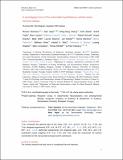A secretagogin locus of the mammalian hypothalamus controls stress hormone release
Abstract
A hierarchical hormonal cascade along the hypothalamic-pituitary-adrenal axis orchestrates bodily responses to stress. Although corticotropin-releasing hormone (CRH), produced by parvocellular neurons of the hypothalamic paraventricular nucleus (PVN) and released into the portal circulation at the median eminence, is known to prime downstream hormone release, the molecular mechanism regulating phasic CRH release remains poorly understood. Here, we find a cohort of parvocellular cells interspersed with magnocellular PVN neurons expressing secretagogin. Single-cell transcriptome analysis combined with protein interactome profiling identifies secretagogin neurons as a distinct CRH-releasing neuron population reliant on secretagogin's Ca2+ sensor properties and protein interactions with the vesicular traffic and exocytosis release machineries to liberate this key hypothalamic releasing hormone. Pharmacological tools combined with RNA interference demonstrate that secretagogin's loss of function occludes adrenocorticotropic hormone release from the pituitary and lowers peripheral corticosterone levels in response to acute stress. Cumulatively, these data define a novel secretagogin neuronal locus and molecular axis underpinning stress responsiveness.
Citation
Romanov , R A , Alpár , A , Zhang , M-D , Zeisel , A , Calas , A , Landry , M , Fuszard , M A , Shirran , S L , Schnell , R , Dobolyi , Á , Oláh , M , Spence , L , Mulder , J , Martens , H , Palkovits , M , Uhlen , M , Sitte , H H , Botting , C H , Wagner , L , Linnarsson , S , Hökfelt , T & Harkany , T 2015 , ' A secretagogin locus of the mammalian hypothalamus controls stress hormone release ' , EMBO Journal , vol. 34 , no. 1 , pp. 36-54 . https://doi.org/10.15252/embj.201488977
Publication
EMBO Journal
Status
Peer reviewed
ISSN
0261-4189Type
Journal article
Description
This work was supported by the Swedish Research Council (T.Ha., T.Hö.), Hjärnfonden (T.Ha.), the Petrus and Augusta Hedlunds Foundation (T.Ha., T.Hö.), the Novo Nordisk Foundation (T.Ha., T.Hö.), Karolinska Institutet (T.Hö.), the Medical University of Vienna (T.Ha.), ANR (France, ANR-10-INBS-04-01, M.L.), the European Commission (PAINCAGE grant, T.Ha.) and the Wellcome Trust (094476/Z/10/Z, equipment grant, C.H.B. and postdoctoral research fellowship, M.F.).Collections
Items in the St Andrews Research Repository are protected by copyright, with all rights reserved, unless otherwise indicated.

